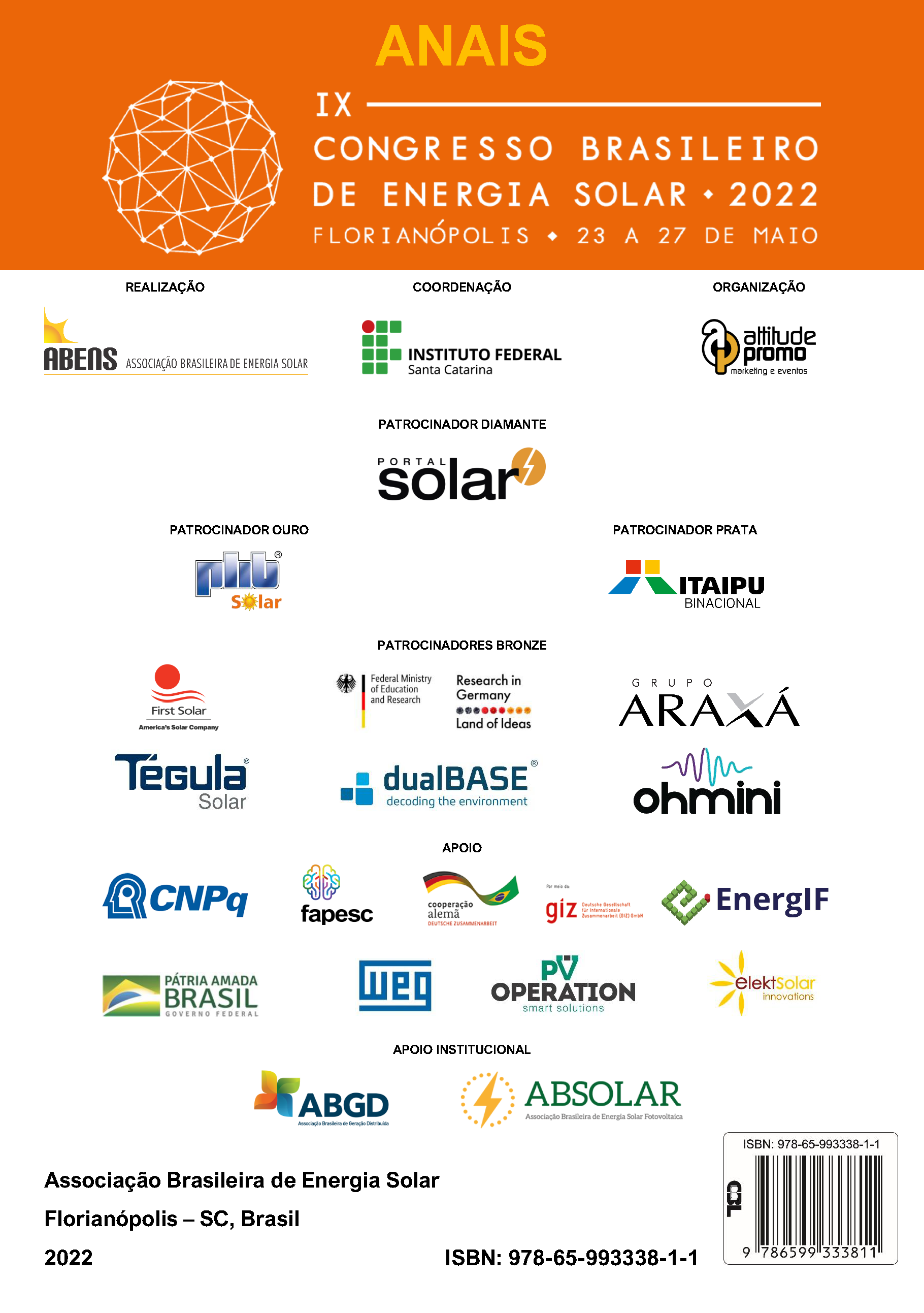CONSTANT DUTY CYCLE SOLAR CHARGE REGULATOR FOR LITHIUM-ION BATTERIES
DOI:
https://doi.org/10.59627/cbens.2022.1053Keywords:
Solar Energy, Photovoltaic, Charge RegulatorAbstract
This article presents the design, implementation, and analysis of the results of a constant duty cycle solar charge regulator to be used in autonomous photovoltaic systems based on lithium-ion batteries. The regulator works with a constant duty cycle, dispensing with feedback from the battery state of charge, reducing complexity and cost. A simulation of autonomous photovoltaic systems is performed to help to explain how the regulator works. In addition, the main design aspects are presented to be compared experimentally with commercial regulators under identical test conditions. In conclusion, the constant duty cycle solar charge regulator suitably achieves the lithium-ion battery full charge and also, it presents an intermediate efficiency with the regulators more complex with a feedback loop. Like, are the maximum power point tracker regulator and the pulse width modulator regulator. In conclusion, the constant duty cycle solar charge regulator is a cost-effective solution, and it is appropriate to be used in autonomous photovoltaic systems.
Downloads
References
Adam, S. M., Wang, K., Ma, J., & Man, K. L. (2021). Soft Modeling of the Photovoltaic Modules Based on MATLAB/Simulink. In 2021 25th International Conference Electronics (pp. 1-6). IEEE.
Bates, J. B., Dudney, N. J., Neudecker, B., Ueda, A., & Evans, C. D. (2000). Thin-film lithium and lithium-ion batteries. Solid state ionics, 135(1-4), 33-45.
Carter, B., Matsumoto, J., Prater, A., & Smith, D. (1996, August). Lithium ion battery performance and charge control. In IECEC 96. Proceedings of the 31st Intersociety Energy Conversion Engineering Conference (Vol. 1, pp. 363-368). IEEE.
Easton, R. L., & Votaw, M. J. (1959). Vanguard I IGY satellite (1958 beta). Review of Scientific Instruments, 30(2), 70-75.
Firman, A. Cáceres, M. Vera, González Mayans, A. de la Casa, J. (2020). Caracterización y extracción de parámetros eléctricos en módulos de lámina delgada. VIII Congresso Brasileiro de Energia Solar – Fortaleza.
Green, M. A. (2002). Photovoltaic principles. Physica E: Low-dimensional Systems and Nanostructures, 14(1-2), 11-17.
Hauke, B. (2011). Basic Calculation of a Buck Converter's Power Stage. Texas Instruments. Low Power DC/DC Applications. Application Report.
International Rectifier (2019). High and low side driver IR2110(S)PbF/IR2113(S)PbF. Data sheet.
Laws, N. D., Epps, B. P., Peterson, S. O., Laser, M. S., & Wanjiru, G. K. (2017). On the utility death spiral and the impact of utility rate structures on the adoption of residential solar photovoltaics and energy storage. Applied energy, 185, 627-641.
Luque, A. and Hegedus, S. (2011). Handbook of photovoltaic science and engineering. Wiley.com.
Manthiram, A. (2017). An outlook on lithium ion battery technology. ACS central science, 3(10), 1063-1069.
Miyatake, S., Susuki, Y., Hikihara, T., Itoh, S., & Tanaka, K. (2013). Discharge characteristics of multicell lithium-ion battery with nonuniform cells. Journal of Power Sources, 241, 736-743.
Niccolai, A., Dolara, A., & Grimaccia, F. (2018). Analysis of Photovoltaic Five-Parameter Model. In 2018 International Conference on Smart Systems and Technologies (SST) (pp. 205-210). IEEE.
Shepherd, C. M. (1965). Design of primary and secondary cells: II. An equation describing battery discharge. Journal of the Electrochemical Society, 112(7), 657.
Shockley, W. (1949). The Theory of p‐n Junctions in Semiconductors and p‐n Junction Transistors. Bell System Technical Journal, 28(3), 435-489. Texas Instruments (2000). LM555 Timer. Data sheet.
Texas Instruments. (2005) Li-Ion Battery Charger Solution Using an MSP430™ MCU. Application Report
Tiwari, G. N., & Dubey, S. (2009). Fundamentals of photovoltaic modules and their applications. Royal Society of Chemistry.
Trano, S. (2021). Safer Lithium-Metal Batteries through Lithium Protection and Thermal-Electrochemical Modelling (Doctoral dissertation, Politecnico di Torino).
Wu, Y., Xie, L., Ming, H., Guo, Y., Hwang, J. Y., Wang, W., & Ming, J. (2020). An empirical model for the design of batteries with high energy density. ACS Energy Letters, 5(3), 807-816.


